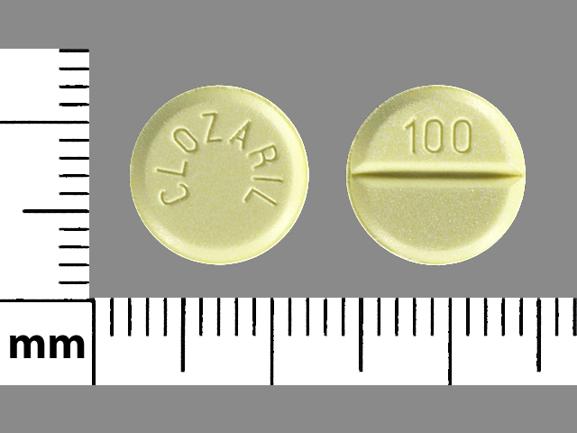Clozaril Dosage
Generic name: CLOZAPINE 25mg
Dosage form: tablet
Drug class: Atypical antipsychotics
Medically reviewed by Drugs.com. Last updated on Jun 6, 2025.
Absolute Neutrophil Count Testing Prior to CLOZARIL Initiation
Prior to initiating CLOZARIL treatment, obtain a baseline absolute neutrophil count (ANC). CLOZARIL initiation is not recommended in patients with an ANC less than 1500/μL.
For patients with documented Benign Ethnic Neutropenia (BEN) (also known as Duffy-null associated neutrophil count), obtain at least two baseline ANC levels. CLOZARIL initiation is not recommended in patients with BEN with an ANC less than 1000/μL.
For dosage modifications based on ANC results, see Dosage and Administration (2.3, 2.4).
Recommended Dosage and Administration
To reduce the risk of orthostatic hypotension, bradycardia, and syncope, the recommended starting dosage is much lower than the target dosage.
CLOZARIL can be taken with or without food. The recommended starting oral dosage of CLOZARIL is 12.5 mg once or twice daily. If well-tolerated, increase the total daily dose in increments of 25 mg to 50 mg per day to achieve a target dosage of 150 mg to 225 mg twice per day by the end of two weeks. Subsequently, may increase the dosage in increments of up to 100 mg once weekly or twice weekly. The maximum recommended CLOZARIL oral dosage is 450 mg twice daily.
Dosage Modifications Based on ANC Results
Table 1 provides recommended CLOZARIL dosage modifications based on ANC results. For dosage modifications based on ANC results for patients with Benign Ethnic Neutropenia (BEN) (also known as Duffy-null associated neutrophil count), see Table 2 .
|
|
|
Recommended Dosage Modification |
Recommended Frequency of ANC Testing During CLOZARIL Treatment |
|
ANC Within Normal Range (≥ 1500/μL) |
|
|
No dosage modification; continue treatment |
|
|
If CLOZARIL treatment is reinitiated after a dosage interruption (e.g., patient had neutropenia which required dosage interruption and now has a normal ANC level) for:
|
|
|
Mild Neutropenia (ANC between 1000 to 1499/μL)* |
|
|
No dosage modification; continue treatment |
|
|
Moderate Neutropenia (ANC between 500 to 999/μL)* |
|
|
|
|
Severe Neutropenia (ANC less than 500/μL)* |
|
|
Discontinue treatment and recommend hematology consultation |
|
Dosage Modifications Based on ANC Results for Patients with Benign Ethnic Neutropenia
Table 2 provides recommended CLOZARIL dosage modifications based on ANC results for patients with Benign Ethnic Neutropenia (BEN) (also known as Duffy-null associated neutrophil count). For dosage modifications based on ANC results for patients without BEN, see Table 1 .
|
Recommended Dosage Modification |
Recommended Frequency of ANC Testing During CLOZARIL Treatment in Patients with BEN |
|
ANC Within the Normal Range for Patients with BEN (≥ 1000/μL ) |
|
|
No dosage modification; continue treatment |
|
|
If CLOZARIL treatment is reinitiated after a dosage interruption (e.g., patient had neutropenia which required dosage interruption and now their ANC (≥ 1000/μL and ≥ the patient’s ANC baseline prior to treatment) for:
|
|
|
Neutropenia in Patients with BEN (ANC level between 500 to 999/μL)† |
|
|
|
|
Severe Neutropenia in Patients with BEN (ANC level less than 500/μL)† |
|
|
Discontinue treatment and recommend hematology consultation |
|
Discontinuation of CLOZARIL Treatment
If discontinuing CLOZARIL in patients with:
- •
- Moderate or severe neutropenia, see Table 1 .
- •
- Normal or mild neutropenia, reduce the dosage gradually over a period of 1 to 2 weeks, and continue monitoring ANC levels until their ANC is ≥1500/μL.
If discontinuing CLOZARIL in patients with Benign Ethnic Neutropenia (BEN) (also known as Duffy-null associated neutrophil count) with:
- •
- Neutropenia, see Table 2 .
- •
- ANC within their normal range of ANC reduce the dosage gradually over a period of 1 to 2 weeks.
When discontinuing CLOZARIL, monitor patients for the symptoms related to psychotic recurrence and cholinergic rebound (e.g., profuse sweating, headache, nausea, vomiting, diarrhea).
Restarting CLOZARIL Treatment After Interrupting CLOZARIL
When restarting CLOZARIL in patients who have interrupted CLOZARIL treatment, use a lower dosage to minimize the risk of hypotension, bradycardia, and syncope.
- •
- If one day’s dosage is missed, resume CLOZARIL treatment at 40% to 50% of the previous dosage.
- •
- If two days of dosing is missed, resume CLOZARIL treatment at approximately 25% of the previous dosage.
- •
- For longer interruptions, restart CLOZARIL treatment with a dosage of 12.5 mg once or twice daily. If this dosage is well-tolerated, may increase the dosage to the previous dosage more quickly than recommended than for initial CLOZARIL treatment.
Dosage Modifications for Drug Interactions
See Table 3 for recommended dosage modifications to reduce the risk of CLOZARIL-associated adverse reactions or reduce the risk of lower effectiveness.
|
Strong CYP1A2 Inhibitors |
Administer one third of the CLOZARIL dosage. |
|
Moderate or Weak CYP1A2 Inhibitors |
Consider reducing the CLOZARIL dosage if necessary. |
|
CYP2D6 or CYP3A4 Inhibitors |
|
|
Strong CYP3A4 Inducers |
Concomitant use is not recommended. However, if concomitant use is necessary, it may be necessary to increase the CLOZARIL dosage. Monitor for decreased effectiveness. |
|
Moderate or weak CYP1A2 or CYP3A4 Inducers |
Consider increasing the CLOZARIL dosage if necessary. |
More about Clozaril (clozapine)
- Check interactions
- Compare alternatives
- Pricing & coupons
- Reviews (15)
- Drug images
- Latest FDA alerts (9)
- Side effects
- During pregnancy
- Generic availability
- Drug class: atypical antipsychotics
- Breastfeeding
- En español
Patient resources
Other brands
Professional resources
Other brands
Related treatment guides
See also:
Further information
Always consult your healthcare provider to ensure the information displayed on this page applies to your personal circumstances.


